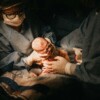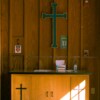
Literature and Theology: New Interdisciplinary Spaces
Reviewed by Rachel Pietka, English, Baylor University
Literature and Theology: New Interdisciplinary Spaces takes its place among other similar projects that have been published in the last few years: Finding a Common Thread: Understanding Great Texts from Homer to O’Connor (2013), Hard Sayings: The Rhetoric of Christian Orthodoxy in Late Modern Fiction (2013), Between Truth and Fiction: A Narrative Reader in Literature and Theology (2010), and Mark Knight’s An Introduction to Religion and Literature (2009). While each book has a specific end in mind, varying from instructing Christian educators how to teach great texts to defending theology’s resilience in the face of postmodernism, their very existence and contemporaneity indicates the health and popularity of an interdisciplinary field that is established but whose identity is flexible.
In the brief introduction to Literature and Theology, editor Heather Walton draws attention to the extraordinary interest in the relationship between these disciplines over the past two decades, justifying her project by asserting that both fields, whether joined or separate, are changing. For example, theologians who study literature have begun to realize that literature does not so easily conform to their work, as in the days when all disciplines pointed to theology. At the same time, literature departments have begun to steer away from critical theory and are thus redefining what it means to do research in their discipline. Although Walton warrants the publication of another book on religion and literature by pointing to the current changes and challenges in these fields, her introduction does not provide the reader with an adequate overview of what “new interdisciplinary spaces” are presented in the book. She does, however, use a particular word in her introduction that offers a clue as to what she means by her subtitle: “beyond” (2). With this word, Walton implies that amid all the different perspectives through thirteen chapters, there is at least one commonality: the idea of the beyond, the transcendent. All the contributors agree, to a certain extent, that literature and theology occupies a space outside disciplinary boundaries and, more often than not, human comprehension. Consequently, it seems that words like “beyond,” “outside,” “boundless,” “openness,” “mystery,” and “ambivalence” have come to characterize new directions in the study of literature and theology, though attempting to demarcate these directions, as we will see, is somewhat antithetical to this particular interdisciplinary project.
The first two chapters contribute most directly to the new theoretical framework to which Walton alludes. David Jasper, in the opening chapter, takes readers for a brief walk through the history of interdisciplinary work involving literature and theology, starting with T. S. Eliot and focusing on the academic climate of the last few decades. As “interdisciplinary” connotes a tendency for one discipline to subsume another for the purpose of its own enhancement, Jasper suggests the term “intradisciplinarity” for the study of religion, literature, and the arts because this term conveys an interest in “how” literature or art communicates and not as much in “what it says” (9). Central to this sort of scholarship is an acknowledgment of and respect for mystery and the ineffable qualities of the work being studied. He models this kind of scholarship by discussing four novels and one work of visual art: Cormac McCarthy’s The Road, Michael Frayn’s Sweet Dreams, Harry Mulisch’s Siegfried, Thomas Keneally’s Schindler’s Ark, and Eric Gill’s woodcut The Nuptials of God. In the next chapter, Andrew W. Hass’s pithy title “Discipline Beyond Disciplines” suggests, not unlike Jasper’s essay, that the study of literature and theology requires an openness toward mystery and a suspension of modern assumptions about scholarly work, specifically the assumption that knowledge can be possessed and controlled. As this chapter focuses on the “beyond,” Hass analyzes José Saramago’s Blindness to draw attention to a text that goes beyond metaphor by presenting “the metaphorical as a ‘meta’-metaphor” (33).
In the next two essays, Heather Walton and Alana Vincent broach interpretive issues in literature and theology. Walton explores the metaphor of romance, wherein literature is female and theology is male, and discusses alternatives to this model through theorists Julia Kristeva and Luce Irigaray as well as the novels Atonement by Ian McEwan and Elizabeth Costello by J. M. Coetzee. She concludes that scholars should be reminded of the beyond when faced with the limitations and flaws not only of research and interpretation, but the disciplines themselves. Vincent’s essay transitions from Walton’s general interpretive problem by starting with a specific, well-known one in literary studies: exactly which towers does the second book of J. R. R. Tolkien’s trilogy refer to? Vincent then proceeds with her analysis of two actual towers, the Canadian National Vimy Memorial located in Northern France and the Kaiser-Wilhelm-Gedächtniskirche in Berlin. Drawing on the uncertainty surrounding Tolkien’s towers, this essay suggests that reading two architectural structures together, like reading texts from different disciplines, “heighten[s]” the “ambiguity” (56). In her conclusion, she notes, with optimism, that interdisciplinarity encourages scholars to relinquish control and certainty.
In the fifth chapter, Mattias Martinson initiates the discussion of what he calls the “post-Christian” age, particularly the ways in which current, non-Christian ideological assumptions have opened up new and helpful ways for studying literature and theology. He discusses The Monstrosity of Christ (2009), which was co-authored by John Milbank, a “radical orthodox theologian” and Slavoj Žižek, an atheist and political philosopher, as an example of one of the new and previously unlikely conversations that has emerged from a post-Christian situation (68). This essay also draws extensively on the work of several German writers and thinkers after World War I and concludes with the argument that theology needs to avoid an “emphatic” language in favor of a discourse that is more fluid, accepting, and free of underlying standards that measure all things against Christianity (79).
Alison Jasper and Fiona Darroch write the next two chapters, in which they continue to explore how the post-Christian era has enhanced their scholarship. Jasper writes about Jane Leade, a Puritan woman who lived in seventeenth-century England, in order to draw attention to the understudied contributions of women to the church, an approach made possible by wider definitions and more porous boundaries pertaining to “the sacred” (81). Darroch focuses on Caribbean writers, particularly Derek Walcott, David Dabydeen and Fred D’Aguiar, to analyze representations of the sea as an in-between, indeterminate, and often contradictory space where new discourses and understandings of “religion” and “sacred” are formed (99). She also comments on her methodology and argues that combining postcolonial literary theory and religious studies not only advances the vision of the Caribbean writers, but creates new interdisciplinary space for scholars.
Chapters 8 and 9 deal with theological aesthetics, particularly the concern that theology and philosophy do injustice to art through categorization. John O’Connor accounts for problems in the discipline of theological aesthetics, frequently referencing Hans Urs von Balthasar, Richard Viladesau, John McDowell, Immanuel Kant, and Jacques Maritain. Ultimately, O’Connor argues that the study of beauty needs a more proper interdisciplinary practice that involves broaching theological aesthetics through philosophy and recognizing, not merely in word, the “elusiveness,” “complexity,” “ambiguities,” and “tensions” inherent in the beautiful (123). Paul Fiddes explores different schools of thought relating to beauty and the sublime, contrasting theologians who have rejected the negative sublime, in which beauty and sublimity clash rather than harmonize, with two writers who present versions of this idea in their work: novelist Iris Murdoch and poet Gerard Manley Hopkins (127). Allowing for the negative sublime in our thoughts and research, Fiddes argues, will result
in an understanding of the “theological sublime” that is “more varied” and open (148). The next two essays examine expressions and gestures of love in literature. Mark Godin expounds on touch as a “dynamic icon” for the study of literature and theology (154). He uses representative texts, such as Graham Ward’s reading of the biblical story of the bleeding woman who touches Jesus’ clothes for healing, Gabriel Josipovici’s book Touch which cannot be categorized but spans multiple genres, and Michael Ondaatje’s novel Anil’s Ghost. By drawing parallels between diverse depictions of touch in literature and the way in which theology and literature encourages a similar kind of contact between two metaphorical beings, Godin presents a model for interdisciplinarity that facilitates love and intimacy, ensuring that neither discipline is dominated by the other. The interdisciplinary work of Pamela Sue Anderson’s essay connects the life of Simone de Beauvoir and her book, She Came to Stay, with human experience, specifically the universal narrative of love and death. Although Anderson combines the study of both life and text in this essay, she does not clearly explain or demonstrate how her project constitutes a new way to study literature and theology; neither does she show how her approach interacts with, improves, or enriches other models for similar research.
This book fittingly concludes with two old friends of literature and theology: C. S. Lewis and Samuel Taylor Coleridge. Christine Hsiu-Chin Chou analyzes Lewis’s The Screwtape Letters, a text she asserts necessitates interdisciplinary reading to match its dual theological and literary viewpoint, presented in the language of irony. In the final essay, Kelly Van Andel uses Coleridge’s theory of the symbol to discuss how scholarship of literature and theology is often polarized: either there is, as T. S. Eliot believed, a clear measuring stick by which to assess all things, or literature and theology have nothing to do with one another. Like many other writers in this volume, Van Andel argues for interdisciplinary space that allows for tension between divided perspectives, not the obliteration of one by the other. She puts forth Coleridge as an exemplar of one who embraced uncertainty, mystery, and ambiguity, and who creates in his work an interdisciplinarity that locates the reader in a “non-place,” thereby remaining open to what is different and unfamiliar (212).
The essays in this collection are effectively organized by topic or theoretical approach, as the book begins with what Walton calls the “panoramic” perspectives of David Jasper and Andrew W. Hass, continues with several different topics pertinent to literature and theology, and concludes with chapters on two foundational authors for interdisciplinary work that also present specific claims (2). Additionally, this volume contains thirteen chapters that, for the most part, articulate similar ideological viewpoints and are based upon similar assumptions. Ideas associated with openness, mystery, and ambivalence are explored and privileged in ways that are surprisingly not redundant but fresh, diverse, and compelling. At the same time, these essays remain unified in their attempts each to show a particular piece of a complex picture representing the study of literature and theology. Consequently, this book touches upon many different discussions, philosophical frameworks, and authors. Feminism makes an appearance, but so does C. S. Lewis. Theological aesthetics guide two essays and one is primarily about two actual architectural structures, the discussion of which connects to J. R. R Tolkien’s The Two Towers. There is great diversity in this book, but the connections and transitions are clear and graceful.
The greatest strength of the ideological assumptions of this book, which I have termed “the beyond,” is that such an approach has the potential to foster intellectual humility. As Paul J. Griffiths’s recent book Intellectual Appetite: A Theological Grammar (2009) reveals, the idea that there could be a right and a wrong, or a virtuous and a sinful, way to gather and use knowledge has been dormant in Western culture since at least the eighteenth century. Although none of the writers included in Literature and Theology cite Griffiths, their use of the beyond in all its various delineations is poignantly similar to Griffiths’s concerns regarding intellectual attitudes and appetites in the academy. Encouraging scholars, especially Christian ones, to recognize their limitations and God’s grandeur through literature and theology is a worthwhile endeavor.
The lack of justification, however, for privileging the idea of the beyond in this collection is a potential problem. The concept of “god-terms,” which rhetoricians use to refer to words or phrases that signify ideas or values holding specific meanings, whether positive or negative, for a community at a certain time and place, is useful here, for the contributors to Literature and Theology tend to use god-terms in lieu of explaining their why readers should accept their ideological foundations. For example, the writers who reference T. S. Eliot’s model for scholarship assume that having a complete and indisputable measuring stick against which to understand the world is a detrimental perspective, probably because in the current academic climate, words like “complete” or “indisputable” as well as those denoting acts of measuring or judging are god-terms that carry negative connotations. Of course, this was intentional on the part of the writers and editor, for one of the unstated goals of this project is to speculate how to study literature and theology today, which necessitates taking into account the current academy’s assumptions. While these assumptions may indeed be viable building blocks for scholarship, they have not been thoroughly investigated and justified for the reader. Scholars of literature and theology would therefore benefit from deeper work on the god-terms of postmodernism, and their manifestations, before they embrace the new interdisciplinary spaces this book explores.






















